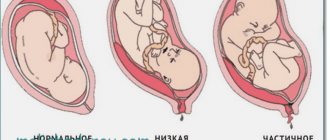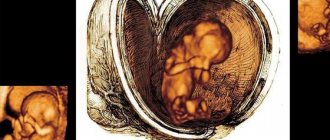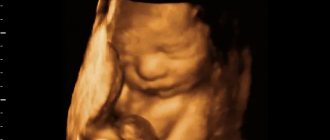Baby at 32 weeks of pregnancy
The longer the baby develops, the more perfect his body becomes. All organ systems gradually carry out their functions. The organs of the endocrine system produce hormones, the kidneys produce and excrete urine, the digestive system processes amniotic fluid, which partly consists of meconium. The nervous, immune and respiratory systems, as well as bone and adipose tissue, continue to develop. Despite the fact that the bones become stronger, the bones of the baby’s skull are quite pliable and can move relative to each other, which is necessary for the baby to pass through the birth canal.
A child at 32 weeks of pregnancy is not yet able to control his movements. Even after birth, almost all of his motor activity is due to the presence of unconditioned reflexes. However, at this time a connection is established through which the central nervous system regulates muscle activity. It is believed that it is at 32 weeks that the baby’s sucking reflex improves.
Externally, the baby is very similar to a newborn, but the subcutaneous fatty tissue is not yet fully developed. Little by little, the vernix lubrication and lanugo, the fluff that covers the baby in the womb, disappear from his body. Sometimes babies are born with areas of skin covered with this fluff, but within a few hours after birth the lanugo disappears from the baby’s skin.
The normal weight of the fetus at the 32nd week of pregnancy is 1800-1900 g, however, the weight of the child at the 32nd week of pregnancy can vary significantly due to genetic characteristics. The weight of children after birth has a wide range, so do not worry if your baby’s parameters are slightly outside the norm. The baby's height already reaches 42 cm, and his heart rate is 120-160 beats/min.
Week 32Your baby is the size of a jicama
Breech presentation of the fetus at 32 weeks of gestation
By this time, babies, basically, already occupy the position from which they will be born. As a rule, this is a cephalic presentation, when the baby's head is located downward, and his buttocks and legs are upward. But due to certain circumstances, due to the presence of certain things in the body of the mother or baby, the child may take a “sitting” position. This is a breech presentation, which is considered pathological by doctors, since it is fraught with various complications during and after childbirth. And yet the baby has every chance of turning over. For this, there are special exercises that a pregnant woman can perform if the doctor does not see any contraindications to this. Therefore, do not worry ahead of time and talk to your gynecologist.
Changes in the body of the expectant mother
What changes every week is the size of the belly, the sensations from the baby’s movements and the well-being of the pregnant woman. Perhaps these moments seem almost unnoticeable, but if you compare with the previous trimester, the difference is quite noticeable. When the 32nd week arrives, the pregnant woman’s weight gain should not be more than 12 kg, so that this does not affect the baby and your figure. After all, it is easier to maintain normal weight than to lose it for a long time and painfully.
Belly at 32 weeks pregnant
The belly seems very big, and I can’t even believe that this is not the limit. He is already supporting his ribs and may have stretch marks. As sad as it may be, stretch mark cream is not always able to ensure their absence. If now they catch your eye and upset you, then after giving birth, over time they will become light and will be hardly noticeable.
From the symphysis pubis to the fundus of the uterus it is already 32 cm. The uterus has risen so high that it puts pressure on the ribs, which can be very uncomfortable for a woman. You should not be alarmed by uterine contractions if they are not accompanied by pain, discharge and are periodic. This is how false contractions appear, through which the muscles of the uterus are tuned to the upcoming true contractions. But if you notice that the interval between contractions is shortening and there is discharge (watery or bloody), and you are experiencing pain, immediately call an ambulance.
The tone at 32 weeks of pregnancy, which appears from time to time, should also not frighten the expectant mother, if it is short-lived and not accompanied by other unpleasant symptoms. As a rule, it can occur with increased physical activity, because not all women can afford to reduce it as much as possible. Also, the muscles of the uterus become toned after sudden movements and when a pregnant woman falls. The uterus quickly relaxes if you just lie down for a while. But if your stomach becomes stiff, hurts, and specific discharge appears, call an ambulance.
Discharge at 32 weeks of pregnancy
By this time, women are already accustomed to constantly using pads due to discharge, which is an integral part of pregnancy. If they are clear and odorless, this is completely normal. But when they change their consistency, color or smell, a pregnant woman should pay attention to this and consult a doctor. If there is leakage of water (the discharge is abundant and watery), this can lead to the entry of pathogenic microorganisms into the uterus, which will lead to infection of the fetus. If blood appears, there is a risk of placental abruption. If the percentage of detachment is high, then this can be fatal for the baby and his mother. If the nature of the changes favors infection (inflammatory process, candidiasis), this can also lead to infection of the fetus. For example, if a woman is not treated for thrush, which can develop due to a weakened immune system, then the child will become infected when passing through the birth canal. That is why, if any changes appear in the discharge of a pregnant woman, you should not ignore them.
Movements at 32 weeks of pregnancy
The baby can no longer make active movements, occupying almost all the space in the uterus. He puts out his arms and legs, rests his buttocks on his mother’s tummy. Despite the fact that the baby can no longer move fully, the pregnant woman should note the number of his movements during the day (the norm is about 10 movements) so as not to miss changes in his activity. Why is this so important? Sometimes such changes indicate that something is wrong with the baby. If a woman notices this in a timely manner, then there is a chance to help the child.
Childbirth at 32 weeks of pregnancy
Not all babies are born on time. The birth of a baby before the 38th week of pregnancy is called premature birth. During this period, he cannot independently cope with environmental factors. To support respiratory function and thermoregulation, as well as help his immune system, doctors place a premature baby in special conditions and monitor his condition until the little body is able to function independently. There are always risks, but babies born at 32 weeks have a good chance of surviving and growing up healthy.
Ultrasound at 32 weeks of pregnancy
If you have not yet had your third ultrasound examination, it is quite possible that you will be scheduled for one this week. The last ultrasound is of great importance for doctors, as it is indicative. The ultrasound specialist pays attention to all dimensions of the child to determine whether his development is normal or lagging behind. He can also evaluate the development of the heart, brain and all its structures, and look at the location of internal organs. It is imperative to determine the amount of water, position and condition of the placenta in order to eliminate risks to the life of the fetus. In addition, by examining the pelvic organs through the vagina, the ultrasound specialist will accurately determine the length of the cervix.
A short cervix during pregnancy at 32 weeks can be a reason for hospitalization, especially if this is accompanied by its softening. Normally, the length of the cervix should be at least 3.5 cm, since it supports the uterus with the amniotic sac and its shortening can lead to premature birth.
Nutrition

It is recommended to build proper nutrition for a pregnant woman at 32 weeks according to some rules:
- eat often, but not much. It is ideal to eat 5-6 times a day every 2-2.5 hours;
- stop eating until you feel full;
- do not mix different dishes at one meal;
- The last meal is 2-3 hours before bedtime. If necessary, you can curb your appetite with yogurt or fruit;
- drink about 1.5 liters of fluid per day, unless the gynecologist prescribes otherwise;
- exclude harmful foods, avoid semi-finished products, pickles, smoked foods, dried foods;
- completely avoid strong tea and coffee, unless otherwise prescribed by the gynecologist;
- consume a minimum of salt.
Following these recommendations can significantly reduce the manifestation of unpleasant sensations caused by the growth of the uterus: constipation, flatulence, heartburn.
To provide the fetus and your own body with the necessary nutrients, it is recommended to consume:
- red meat, offal, fish (preferably sea), daily;
- dairy products (cottage cheese, cheese, kefir);
- porridge (buckwheat, rice, oatmeal, etc.);
- chicken eggs (daily);
- vegetables and fruits (carrots, pumpkin, broccoli, asparagus, cauliflower, bananas, apples);
- dried fruits;
- berries.
Ideally, if you can include at least one of these products in your daily diet.
Vitamins
It is recommended to take multivitamin complexes and dietary supplements at the 32nd week of pregnancy strictly as prescribed by the gynecologist. You should not self-prescribe. To correctly determine the required dosage and the appropriate complex, the doctor evaluates the test results, the woman’s health status, takes into account regional characteristics and other factors.
It is worth remembering that an excess of certain elements can be no less harmful than their deficiency.
Necessary studies and analyzes
In the third trimester, pregnant women need to visit a doctor once every 2 weeks. For each such visit, the gynecologist must have the results of a urine test, which the woman first submits. Based on the results of OAM, it is sometimes possible to determine asymptomatic pyelonephritis or confirm gestosis, so this analysis is important. If a woman is prone to anemia, she is also prescribed a blood test, the results of which can show changes in hemoglobin levels.
When examining a pregnant woman, the doctor each time measures the parameters of the abdomen (its circumference and the height of the uterine fundus) and listens with the help of an obstetric tube to how the baby’s heart beats. It is also necessary to regularly weigh the woman to monitor the dynamics of her weight, as well as measure blood pressure. At this time, the gynecologist can conduct examinations of the cervix, as well as take a smear to determine the microflora.
In addition, a woman may be prescribed fetal cardiotocography if this has not been done previously. When assessing the results of CTG, scores are given, the level of which can be used to assess how well the baby feels. Serious deviations will be an indication for emergency childbirth.
CTG norms at 32 weeks of pregnancy
The baby's condition is assessed using the Fisher scale, which is scored from 1 to 10 points. These scores are made up of several indicators, which include heart rate, its slightest changes, contractions of the uterine muscles and other factors.
- A score of 1 to 5 points indicates that the baby is not getting enough oxygen, which can make him feel very unwell.
- A result of 6 to 7 points indicates beginning oxygen starvation.
- 8 – 10 points – an indicator of good fetal well-being.
Medical procedures

Regular urine samples for analysis before visiting the doctor have become a common procedure for you. Perhaps the doctor will also refer you for blood tests - general, biochemical, sugar levels, if there are any deviations in your health or previously identified health problems. During a routine examination, the doctor will perform the following manipulations:
- weigh the patient;
- measure blood pressure;
- determine the height of the uterine fundus, abdominal circumference;
- listen to the fetal heartbeat using a stethoscope;
- feels the abdomen to determine the location of the fetus;
- examine the limbs for swelling.
Ultrasound
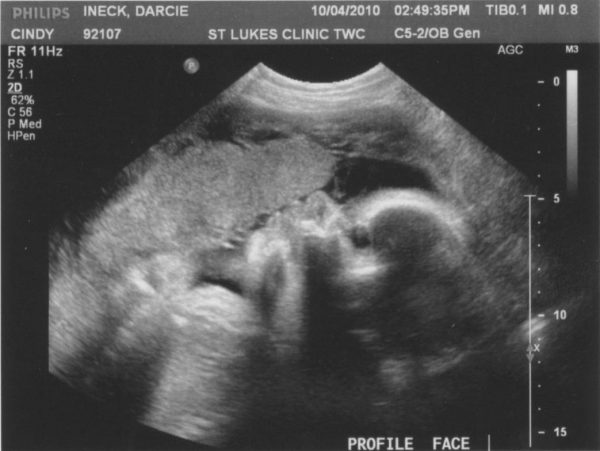
At 32 weeks, you may be scheduled for a scheduled ultrasound of the third trimester, usually the last one before childbirth, if there are no pathologies. The next ultrasound can be performed at the perinatal center shortly before birth, if you arrive at the medical facility in advance. This procedure is mandatory, because it allows us to identify possible abnormalities in the development of the fetus and the condition of the mother’s reproductive organs, which may become the basis for a caesarean section. The following parameters are assessed:
- position of the fetus in the uterus;
- physical data of the fetus (circumference of the abdomen, head, length of the femur and humerus, etc.);
- weight and height;
- volume of amniotic fluid;
- structure and location of the placenta;
- cervical condition and others.
At the 32nd week, the baby can already take a position in the uterus that will remain until birth. The cephalic presentation (head down) is considered the most preferable and correct . If a breech presentation (legs down) is established, this may be the basis for a caesarean section within the prescribed time frame (normally after 37–38 weeks). However, there is still a chance that the baby will be able to roll over and take a position optimal for natural childbirth. To achieve this goal, the doctor may recommend that the woman perform special exercises and wear a prenatal bandage.
Doctors may also consider the option of surgical intervention in an upcoming birth if they determine that the fetus is large. If a woman has a narrow pelvis, giving birth naturally to a large fetus can be very problematic and can lead to problems for both mother and baby.
Doppler
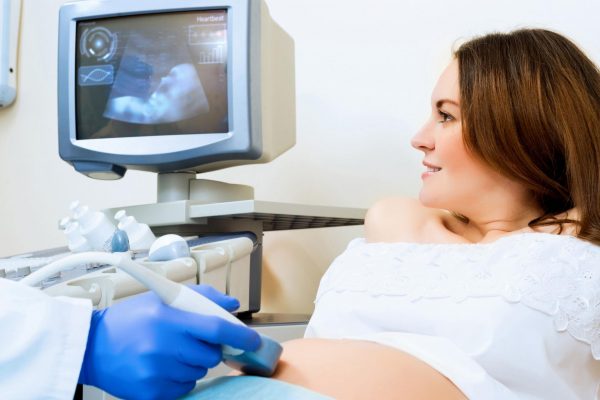
This procedure is necessary to assess the quality of blood flow and oxygen exchange between mother and baby. Usually performed immediately after an ultrasound in the third trimester, or on a regular basis if indicated. The abdomen is lubricated with gel and a sensor is installed. The condition of the blood vessels and the intensity of blood flow in the umbilical cord, placenta, and uterine arteries are checked using ultrasonic waves. The speed and pressure of circulating blood is also assessed, depending on the contraction and relaxation of the heart muscle.
Cardiotocography

CTG sensors are applied to the abdomen (cardiotocography) - a procedure that determines the dependence of the fetal heartbeat on uterine contractions. CTG is usually prescribed for suspected fetal hypoxia or uterine hypertonicity, or for placental insufficiency. The procedure can be prescribed without good reason to check the quality of the fetal heart. The woman is placed on a couch and sensors are connected to her stomach. The mother is advised to lie still, and the procedure lasts 15–30 minutes. At the end of the CTG, the device produces a tape with a fetal heartbeat curve and other data; in appearance, the diagram resembles a familiar cardiogram.
Possible problems
- Nausea at 32 weeks of pregnancy. In the third trimester, some women may develop preeclampsia. This condition is also called preeclampsia, which is accompanied by nausea, swelling and increased blood pressure. The results of a urine test when a woman develops gestosis show an increase in protein. This condition is very dangerous for both the mother and her baby, since if left untreated it can develop into eclampsia. In this case, the pregnant woman begins to have convulsions and may fall into a coma. If she is not hospitalized, it could be fatal. Although in some cases, nausea may occur due to overeating or poisoning.
- Moderate oligohydramnios during pregnancy 32 weeks . The amount of water is accurately determined by ultrasound examination, which is why it should not be skipped. In general, oligohydramnios can occur due to insufficient production of amniotic fluid, due to pathology of the child’s kidneys, or due to leakage of water. Many doctors consider this phenomenon to be a pathology, because even moderate oligohydramnios can affect the health of the baby. And some experts say that it is typical for the last weeks of pregnancy and therefore you should not worry. It must be said that there is really no need to worry too much if moderate oligohydramnios was detected in a timely manner, since doctors prescribe treatment that leads to an improvement in the baby’s living conditions.
- Premature aging of the placenta at 32 weeks of pregnancy . Aging of the placenta is a natural process that is associated with the approach of childbirth. However, aging of the placenta should begin from the 37th week of pregnancy. But if already at the 32nd week of pregnancy there is a 3rd degree of maturity of the placenta (i.e. aging), this indicates the presence of serious problems for the life of the baby, because it is the placenta that provides its body with the necessary amount of oxygen and nutrients. This condition can be detected by ultrasound, and deterioration in the well-being of the fetus can be confirmed using Doppler and CTG. If the baby’s condition worsens, the pregnant woman must be sent to a hospital for further treatment. And if the condition of the fetus can be called critical, an emergency caesarean section is performed.
Stomach
During this period, the expectant mother's abdominal volume will increase by a couple of centimeters. The fundus of the uterus is high, the shape of the abdomen is round. Every day it becomes more and more difficult to walk. This occurs due to the fact that there is a load on the back, and the enlarged uterus puts pressure on the internal organs.
Perhaps you have noticed the metamorphosis that has occurred with your navel? Not only its appearance has changed, but also its shape. A pigment stripe appeared in the middle of the abdomen. For some women it may not appear.
Due to an increase in abdominal volume, the elasticity of the skin may suffer, which is why stretch marks and stretch marks appear.
With the help of special cosmetics for pregnant women, you can maintain the turgor of the skin of the abdomen and chest.
Recommendations for expectant mothers
- Follow the schedule of visits to the gynecologist and undergo all the necessary tests in order to give birth to a healthy baby and avoid various complications.
- Eat right. Give up your favorite unhealthy foods and dishes in favor of steamed food. Add more fiber to your diet to reduce the likelihood of constipation. Consume enough protein, and animal protein. Reduce the amount of salt so that excess fluid is not retained in the body. Deny yourself the pleasure of eating a sweet bun so as not to be surprised by the numbers on the scale later. Drink enough, but control the amount you drink if you are prone to swelling.
- Monitor your weight gain and measure your blood pressure so as not to miss the appearance of the first signs of gestosis. If excess weight is due to swelling, this can be checked by pressing your finger on the skin of the lower leg above the bone. If the dimple persists for some time, this is a sign of edema. Puffiness of the face may also indicate this.
- Do not give up walking in the fresh air to provide your body with oxygen.
- Rest during the day and ask your loved ones to ensure you get as much restful sleep as possible. If you suffer from insomnia, find ways to relax before bed (ask your husband to give you a gentle massage, listen to classical music), ventilate your bedroom, and find a comfortable position for yourself. The best option is to lie on your left side with pillows under your stomach, between your legs and under your back.
- Now is the time to start preparing for childbirth and the addition of another person to your family. Go shopping and buy the things you need, sign up for pregnancy courses, think about where and how you will give birth. If you are considering an option such as partner childbirth, familiarize yourself with everything necessary for this in advance, and also agree with your doctor.
- Don't forget to communicate with your baby and avoid stress and conflict situations.
- Take care of your health and the health of your baby!

